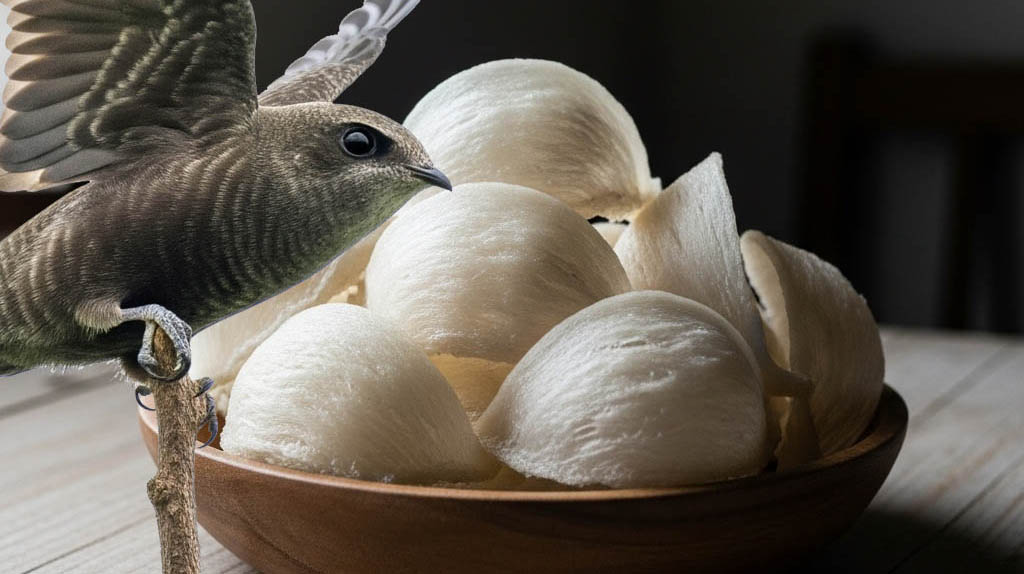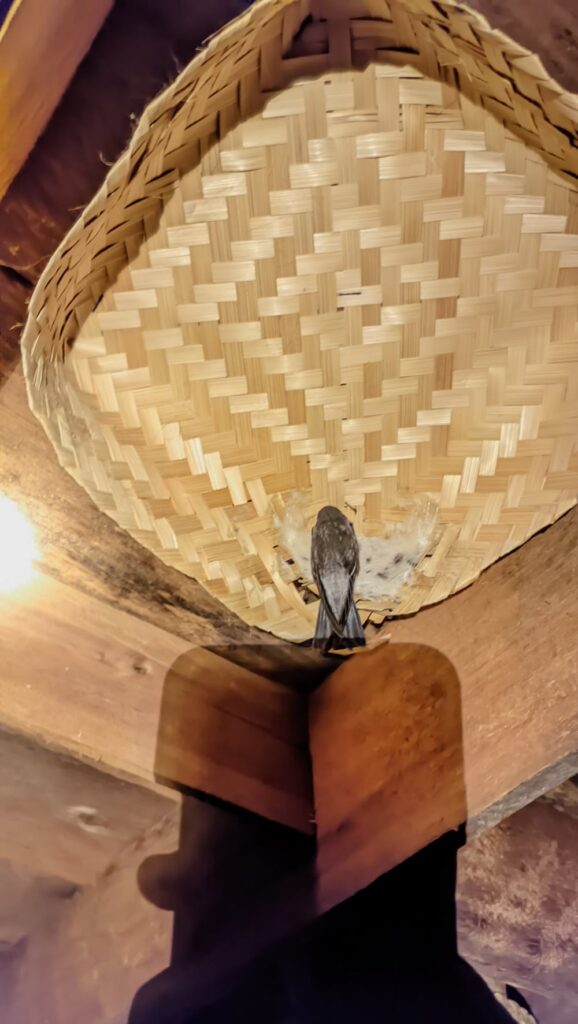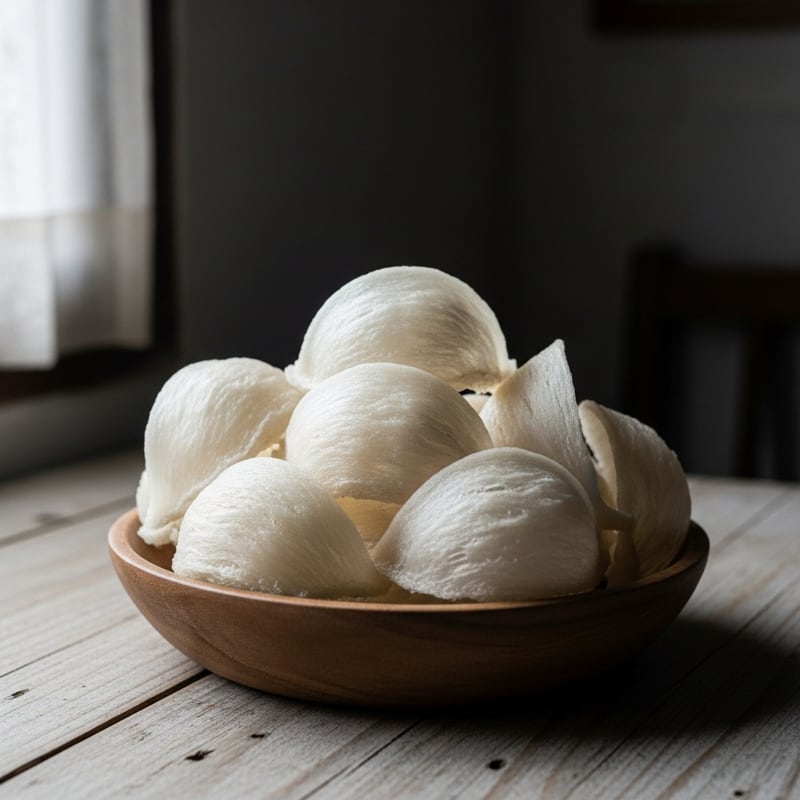
Swallow's Nest in Indonesia: Gold from the Tropical Sky
Swallow's Nest in Indonesia: Gold from the Tropical Sky
1. A Brief Introduction to Bird's Nest
Swiftlet nests are small, grayish-white structures made from the saliva of male swiftlets. Unlike other birds that use twigs or leaves, swiftlets build their nests exclusively from saliva, which hardens when exposed to air. These nests are attached to cave walls or tall buildings and are traditionally harvested for consumption as a highly valued food, particularly in the form of bird's nest soup.
2. Why Bird's Nests Are a Valuable Commodity
The high value of bird's nest stems from its nutritional value and its status as a luxury ingredient in traditional Chinese cuisine and medicine. It is rich in protein, amino acids, and bioactive substances that can boost immunity, accelerate cell regeneration, and maintain healthy skin. Because the production process is natural and requires time and special environmental conditions, production is limited. High demand from international markets—particularly from China, Hong Kong, and East Asian countries—makes bird's nest one of the most expensive animal commodities in the world.
3. Indonesia's Position as a Major World Producer
Indonesia is the world's largest producer and exporter of swiftlet nests, accounting for over 80% of the global supply. This is due to its ideal tropical climate, long coastline, and vast natural and artificial habitats for swiftlets. Many regions in Indonesia, such as Sumatra, Kalimantan, Sulawesi, and Java, have developed swiftlet houses (special buildings for swiftlet farming) on a large scale. The Indonesian government is also actively developing export regulations and certifications to ensure the quality and sustainability of this industry.
Origin and Habitat of Swiftlets
1. Types of Swiftlets that Produce Nests (Aerodramus fuciphagus, etc.)
Swiftlets that produce edible nests generally come from the species Aerodramus fuciphagus, also known as edible-nest swiftlet. This bird is different from swallows or bats, although they are often confused because of their flight form.
Several other types of swiftlets that also produce nests of economic value are:
- Aerodramus maximus (walet hitam),
- Aerodramus salangana.
Namun, A. fuciphagus is the most sought after because it produces a pure white nest which is considered the cleanest, most valuable, and easier to process.
2. Natural Habitat and Adaptation to Swiftlet Buildings
Swiftlets naturally live and nest in the walls of damp, dark limestone caves, especially in coastal areas and tropical rainforests. They use echolocation, like bats, to navigate in the dark.
As market demand increases and natural habitats shrink, humans have begun building swiftlet houses (swallow houses)—multi-story buildings with temperature, humidity, and sound levels designed to resemble natural caves.
Interestingly, swiftlets have adapted remarkably well to these buildings, which have now become the primary source of nest production. The use of calls and the management of indoor conditions have led to the rapid growth of swiftlet farming in both urban and rural areas.
3. Distribution of Swiftlets in Indonesia
Indonesia boasts a geographical advantage and tropical climate that are ideal for the development of swiftlets. This species is widespread in many regions, particularly in:
- Sumatera (Aceh, Jambi, Riau, Sumatera Selatan),
- Kalimantan (Kalimantan Barat, Tengah, Timur, Selatan),
- Sulawesi (Sulawesi Selatan, Tenggara),
- Jawa (Pantura Jawa Tengah dan Timur, Banten),
- Nusa Tenggara Timur (NTT), dan beberapa wilayah Maluku dan Papua.
Some areas have even become centers for swiftlet cultivation with thousands of active buildings supplying nests to domestic and international markets.

The Process of Swallow Nest Formation
1. How Swiftlets Make Their Nests
Swiftlets build their nests using thick, sticky saliva. This saliva is secreted from special glands in their mouths, especially during the breeding season. This process takes approximately 30 to 45 days, during which the male gradually secretes saliva to form a small, bowl-like structure that adheres to the cave wall or interior wall of the swiftlet building.
The nest serves as a place to lay eggs and incubate the young. Once the eggs hatch and the young swiftlets grow large enough to fly, the nest is abandoned and ready for harvest by the breeder.
2. Nest Harvest Season
Swiftlets can build nests two to three times a year, depending on environmental conditions and the population in a building. Therefore, breeders typically harvest nests periodically, including:
- Plunder harvest: harvesting birds before they have a chance to lay eggs. The harvest is clean and valuable, but it can disrupt the birds' reproductive cycle.
- Natural harvesting: This is done after the chicks leave the nest. It's more ethical and environmentally friendly, although the nest's quality may decrease slightly due to use.
Harvest time depends on the rainy season and local climate conditions. Many farmers harvest between March–April and September–October.
3. The Differences Between Nest Types: White, Red, and Black (and the Myths That Go With Them)
There are three types of swallow's nests known on the market:
a. White Nest
- White or light cream color.
- It is the most popular and valuable type.
- Generally produced from pure saliva without any mixture of dirt.
- Easier to clean and process.
b. Red Nest (Blood Nest)
- Red or reddish brown color.
- Popular myth says that the color comes from the blood of swiftlets—but this is not true.
- The red color is usually due to a chemical reaction between saliva and the environment such as high temperatures, high levels of iron, or high levels of ammonia in caves/buildings.
- Because it is rare and exotic, it can be more expensive than a white nest.
c. Black Nest
- It has a mixture of fur and dirt because it is not entirely made of saliva.
- Usually found in natural caves that have not been intensively managed.
- Lower quality and price, and requires a more intensive cleaning process.

Economic Value and Export Potential
1. Local and International Market Prices
Swiftlet nests are among the most expensive animal commodities in the world. Prices vary greatly depending on the quality, color, cleanliness, and shape of the nest.
- Pasar Lokal (Indonesia):
- Harga sarang walet mentah (belum dibersihkan) berkisar antara Rp 7 juta – Rp 15 juta per kg.
- Sarang walet bersih (siap ekspor) bisa mencapai Rp 20 juta – Rp 25 juta per kg bahkan lebih.
- Pasar Internasional:
- Harga ekspor di pasar global seperti Tiongkok atau Hong Kong bisa mencapai USD 2.000 – 3.000 per kg, terutama untuk sarang putih berkualitas tinggi.
- Sarang merah atau blood nest kadang lebih tinggi karena langka dan eksotis.
These prices can rise during times of high demand, especially around Chinese New Year, when bird's nests become a popular gift or food item.
2. Export Destination Country
Indonesia exports swallow's nests to various countries, with China being the largest and most dominant market. Other major destination countries include:
- China (mainland China): the main market with the largest demand.
- Hong Kong: international bird's nest trading and processing center.
- Vietnam and Thailand: as consumers and recycling countries.
- Singapore and Malaysia: transit points as well as direct consumers.
- Taiwan, Macau, and some countries in the Middle East are also potential markets.
Exports to China must meet strict regulations, such as swallow house registration, hygiene standards, and export certificates from the Indonesian government (through the Ministry of Agriculture and the Quarantine Agency).
3. Contribution to the Regional Economy/Small Farmers
The swallow industry has a significant economic impact, particularly in areas outside Java. Some of its contributions include:
- New job opportunities: from breeders, nest cleaners, building managers, to collectors and exporters.
- Source of income for farmers and fishermen: many swallow houses are built by village communities as additional income.
- Regional income: through local taxes and levies from swallow houses or business permits.
- Leading non-oil and gas exports: swiftlet nests are a stable contributor of foreign exchange from the agriculture/livestock sector.
Even in several districts such as South Kalimantan, Riau, and South Sulawesi, swallow farming has become a leading regional sector because it provides a much higher income compared to conventional farming.
Swiftlet Cultivation and Houses
1. Establishment of a Swiftlet Building: Design, Location, Humidity, and Sound
Modern swiftlet farming involves the construction of swiftlet houses, artificial structures that mimic natural cave conditions to encourage swiftlets to nest. Successful cultivation depends heavily on the following factors:
- Building Design
Buildings are typically multi-story (1–4 stories) with thick walls to maintain a stable temperature and limited ventilation to minimize light. The interior is dark and cool, with fin boards for swiftlets to attach their nests to. - Location
Ideal locations are near natural food sources (rice fields, forests, or bodies of water) and away from the noise of large cities. Areas frequented by swiftlets are prime targets. - Humidity and Temperature
Swiftlets prefer 85–95% humidity and temperatures around 27–30°C. Breeders often use humidifiers and cooling machines to maintain these conditions. - Call Sound (Audio Attractant)
Swiftlet calls can be used to attract young birds into the building. A scheduled audio system plays the sounds of male swiftlets to simulate an active colony.
2. Nest Harvesting and Processing Process
- Nest Harvest
Waktu panen When the nest is no longer used by the young swiftlets, this process can occur 2–3 times per year. The nest is manually removed from the fin board, carefully avoiding damage. - Cleaning
After harvesting, the nests are then washed and cleaned of feathers, dirt, and debris. This process can be done manually or with the help of tools. Cleaning affects the quality and selling price of the nests. - Drying and Sorting
Dry the nest naturally or in a low-temperature oven. Once dry, separate the nests by size, color, and shape (whole, broken, flakes). - Packaging and Certification
The nests are packaged in sterile containers complete with quality labels. For export, they require quarantine, laboratory testing, and government certification.
3. Risks and Challenges in Cultivation
Swiftlet farming is promising, but has a number of risks and challenges:
- Predators
Snakes, rats, bats, and even insects such as ants can attack nests or young swiftlets, causing major losses. - Theft
Due to the high price of nests, swiftlet buildings are often targeted by thieves. Security measures include CCTV and night guards. - Climate Disturbance and Noise Pollution
Climate change, drought, or noise pollution from factories and vehicles can disturb the comfort of swiftlets and reduce the population in buildings. - Government Regulations
The government requires swiftlet house registration, quality testing, and zoning regulations. Some regions also prohibit swiftlet houses in densely populated areas due to noise and health concerns. - Market Competition and Price Fluctuations
Nest prices can fluctuate depending on international demand and import regulations in destination countries like China. Farmers must be prepared for market volatility.
Environmental Issues and Regulations
1. Environmental Impact of the Swallow Industry
The bird's nest industry provides significant economic benefits, but also has a number of environmental impacts if not managed wisely:
- Noise pollution: the continuous use of audio attractants in swiftlet buildings can disturb the surrounding community, especially if they are located in residential areas.
- Changes in land use: building swiftlet houses in non-cultivating areas such as residential areas, coastal areas, or even nature reserves can cause spatial planning conflicts and damage local ecosystems.
- Biological waste and sanitation: swiftlet droppings can accumulate and cause unpleasant odors and the potential for disease spread if building sanitation is poor.
- Excessive water and energy use: humidifiers and coolers require large amounts of electricity and water, potentially putting a strain on the local environment.
2. Protection of Species and Natural Cave Ecosystems
Although most production now comes from swiftlet houses, the practice of harvesting nests from natural caves still exists. This raises concerns about:
- Threats to wild swiftlet populations, especially if nests are harvested too early before the chicks have had time to mature.
- Damage to cave ecosystems, including disturbances to other species such as bats, insects, and cave microorganisms.
- Overexploitation: uncontrolled illegal harvesting practices can lead to a decline in swiftlet populations and potential local extinction.
Therefore, it is important to have sustainable harvests that pay attention to the life cycle of swiftlets and maintain the integrity of their natural habitat.
3. Government Policies and Export Regulations (Including Certification)
To maintain the sustainability and competitiveness of the Indonesian swallow industry in the global market, the government has established various regulations, including:
- Swiftlet House Registration: every swiftlet house that will supply for export must be registered and meet sanitation and environmental standards.
- Certification from Animal Quarantine (Barantan): before export, the nest must go through a certification inspection process to ensure it is free from pests, diseases, and safe for consumption.
- Certification from the POM Agency: for processed swallow's nest products that are domestic or that go through a processing process.
- Bilateral negotiations with export destination countries, especially China, which establishes strict export protocols and requires traceability (traceability of the origin of the bird's nest).
- Zoning of swallow farming areas: several regions have established regional regulations (Perda) to regulate the location of swallow house construction so as not to cause conflict with the community.
This regulation aims to maintain product quality, protect the environment, and ensure the long-term sustainability of the national swallow industry.
Innovation and the Future of the Swallow Industry
1. Monitoring and Processing Technology
Technological innovation plays a vital role in improving the efficiency and quality of bird's nest production:
- Digital monitoring system (IoT)
Farmers now use temperature, humidity, and lighting sensors connected to smartphone apps to control the condition of their swiftlet houses in real-time. - CCTV and automated security systems
To prevent theft and continuously monitor swallow activity, especially in remote areas. - Smart audio attractant
Automatic scheduled sound system, with volume control and latest recordings to attract young swiftlets more effectively. - Modern swallow nest processing
Some companies have begun using semi-automatic bird's nest cleaning machines to improve efficiency, hygiene, and quality consistency. This technology also reduces physical damage to the nests.
2. Potential for Development of Derivative Products
Bird's nest is not only in the form of soup, but also has great potential to become various derivative products with high added value:
- Health products
Such as capsules, powdered drinks, or liquid supplements that are claimed to help cell regeneration, improve immunity, and maintain vitality. - Cosmetics and skincare
The epidermal growth factor (EGF) content in bird's nest is a material used in making anti-aging creams, facial serums, and masks because it can repair skin tissue. - Modern food and drink
Bird's nest is now starting to become a mixture of healthy drinks, desserts, jelly, and even premium bubble tea.
With this product innovation, the swallow industry is no longer dependent on raw material exports, but can enter the end consumer market with higher economic value.
3. Directions for Sustainable Development of the Swiftlet Industry
To ensure that the swallow industry continues to grow without damaging the environment and harming society, the future direction must be towards:
- Environmentally friendly cultivation
With the use of renewable energy, waste management, and harvesting systems that do not disrupt the life cycle of birds. - Education and training of livestock breeders
Transferring knowledge to smallholder farmers about new technologies, hygiene standards and sustainable farming practices. - Strengthening regulations and spatial planning
Enforcement of regulations regarding swallow house zoning, building standards, as well as noise control and sanitation. - Market diversification and global branding
Indonesia, as a major producer, can strengthen the "Sarang Burung Indonesia" brand through promotions at international exhibitions, e-commerce, and cross-border trade cooperation.
By combining technological innovation, product diversification, and sustainability principles, the Indonesian swiftlet industry has a great opportunity to become a global leader that is not only economically profitable, but also ecologically and socially responsible.
Closing
Swiftlet nests are not just a valuable commodity, but also a symbol of Indonesia's rich biodiversity and economic opportunities. As the world's largest producer, Indonesia plays a strategic role in supplying the global market for quality swiftlet nests. This industry has created jobs, stimulated regional economies, and provided significant income for thousands of smallholder farmers.
However, behind its enormous economic potential comes great responsibility. Swiftlet farming must be sustainable, preserving species and habitats, while prioritizing environmentally friendly practices and complying with regulations. Innovation and modernization are key to increasing competitiveness without compromising the ecosystem.
Let's support the development of a sustainable and inclusive bird's nest industry—so that its benefits are not only felt today but also passed on to future generations. This potential belongs to all, and maintaining its sustainability is a shared responsibility.
